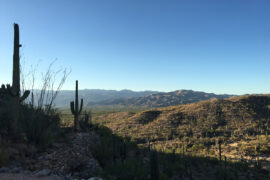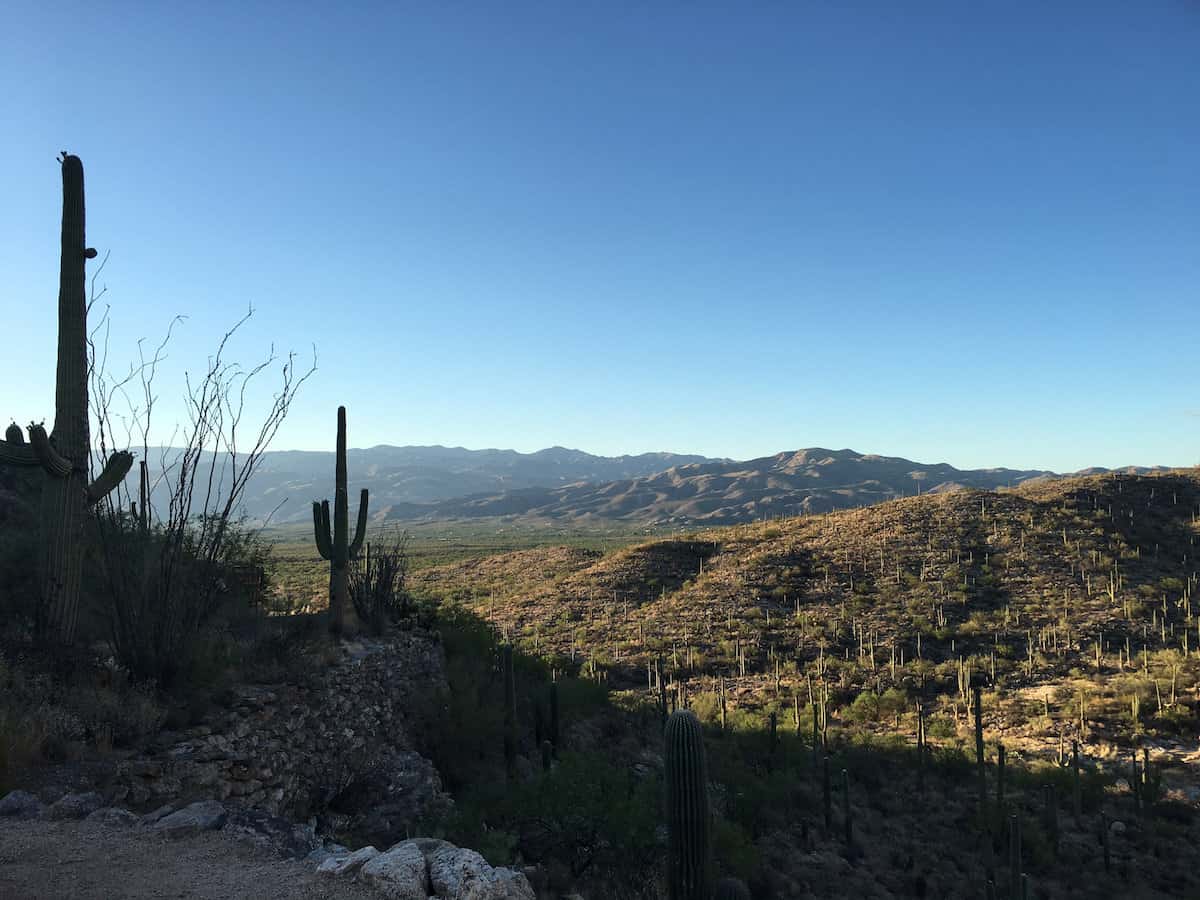
Saguaro National Park straddles Tucson’s east and west sides in southern Arizona. First-time visitors need to know if it offers two different districts: an eastern and a western district. Visitors will find the desert a rich landscape to explore with unique wildlife, especially from fall to spring. This national park also protects an iconic symbol of the desert southwest–the Saguaro Cactus. You can see the best of the park by hiking, biking or along its scenic drive. As the day fades, the sky pops a vibrant orange as it slowly deepens to indigo and then to star-studded black. Here are the top fun things to do in Saguaro National Park for your next desert trip.
Saguaro National Park at a Glance
| Year Established: 1994 |
| Located: Southern Arizona |
| Size: over 91,000 acres |
| Top Features: iconic Saguaro Cactus and Hohokam Petroglyphs |
Should I Visit Saguaro National Park?
Saguaro National Park is the only national park dedicated to one species of cactus. It is an icon of the desert southwest, and the best place to see the Saguaro cactus is in this park. It’s also an easy road trip stop for those driving along Interstate 10 which is why I’ve visited several times with my kids. However, it lacks lodging and dining, so plan ahead.
On my first visit years ago, I planned to explore the park for a few hours and walk amongst the Saguaro. It was a road trip stop on my way to Southern California. Looking at my map, the park’s west side was most convenient for me to reach. When I arrived, the park ranger on the west side informed me that most of the saguaros were found on the east side of the park. I didn’t have time to circle back.
So, plan ahead to make the best use of the vacation time.
Top Things to Do in Tuscon Arizona
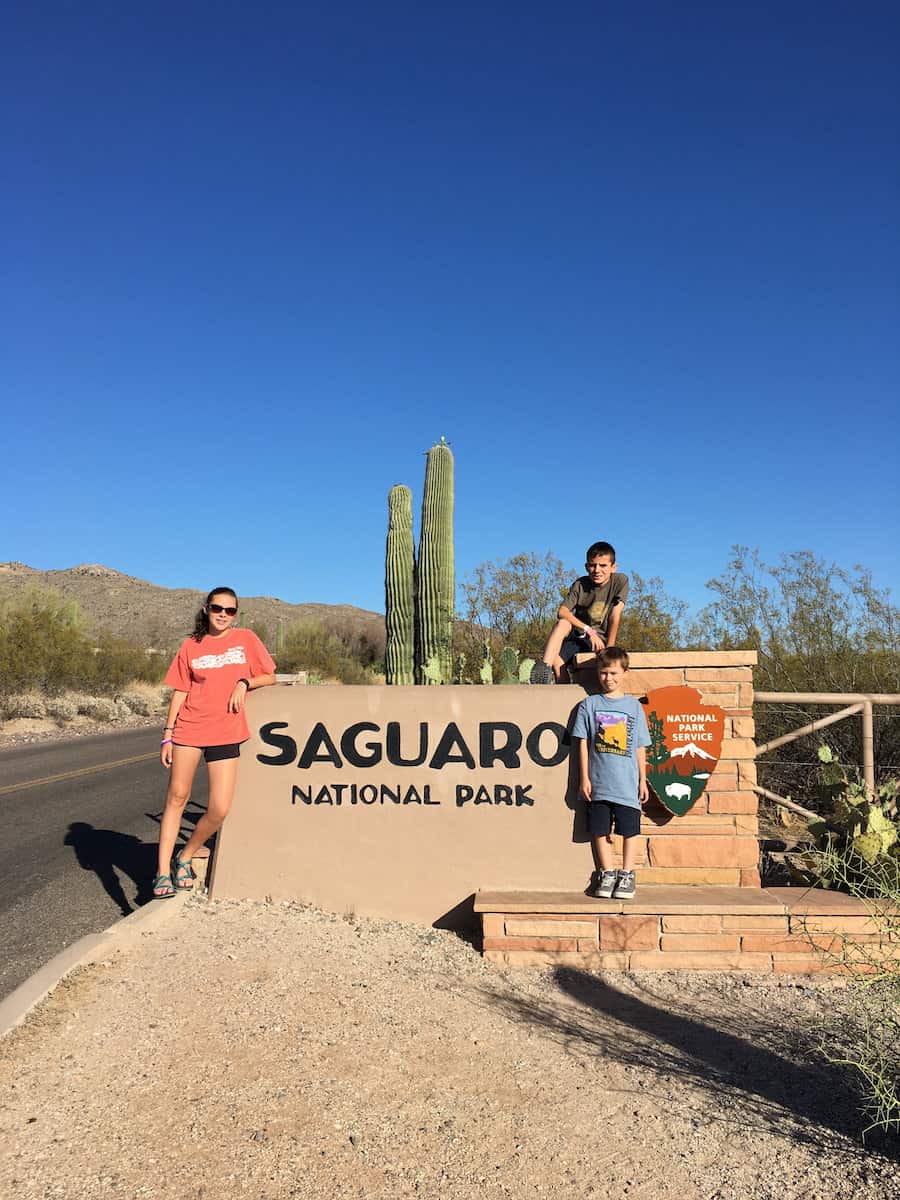
Which Side of Saguaro National Park is Better
First, decide what you want to see. If it’s a quick visit, you can’t visit both sides in a couple of hours due to traffic in and around Tucson. I made this mistake on my first visit. Both sides offer a visitor center, hiking, and interesting sites to discover.
With two sides of Saguaro National Park separated by the majority of Tucson (and its traffic), first-time visitors will want to visit the east side if limited on time. The east side of the park (Rincon Mountains District) features the Cactus Forest Loop Drive that takes cars through a forest of Saguaro. It has the most cactus.
If you want to take a short hike, get out and walk the Desert Loop Ecology Trail on the east side. It offers a high concentration of saguaro cactus, and you might even see a roadrunner. I did this one with my kids.
For desert mountain scenery and petroglyphs, the west side of the park (Tucson Mountain District) offers both. After stopping in the visitor center, take the Desert Discovery Trail to get a sampling of the desert landscape. Then head to Signal Hill for the petroglyphs. Both trails are short.
9 Top Things to do in Saguaro National Park
- Stop by the Visitor Center on the Side of Saguaro National Park you are visiting
- Enjoy the Scenic Drive
- Take a Hike in Saguaro
- Learn more about the Desert Southwest by attending a Ranger Program or completing a Junior Ranger Badge
- See some Desert Wildflowers
- Spot a Road Runner
- Picnic in Saguaro National Park
- See the Sun Set over the Desert
- Camp in Saguaro National Park
Planning Guide to Joshua Tree National Park
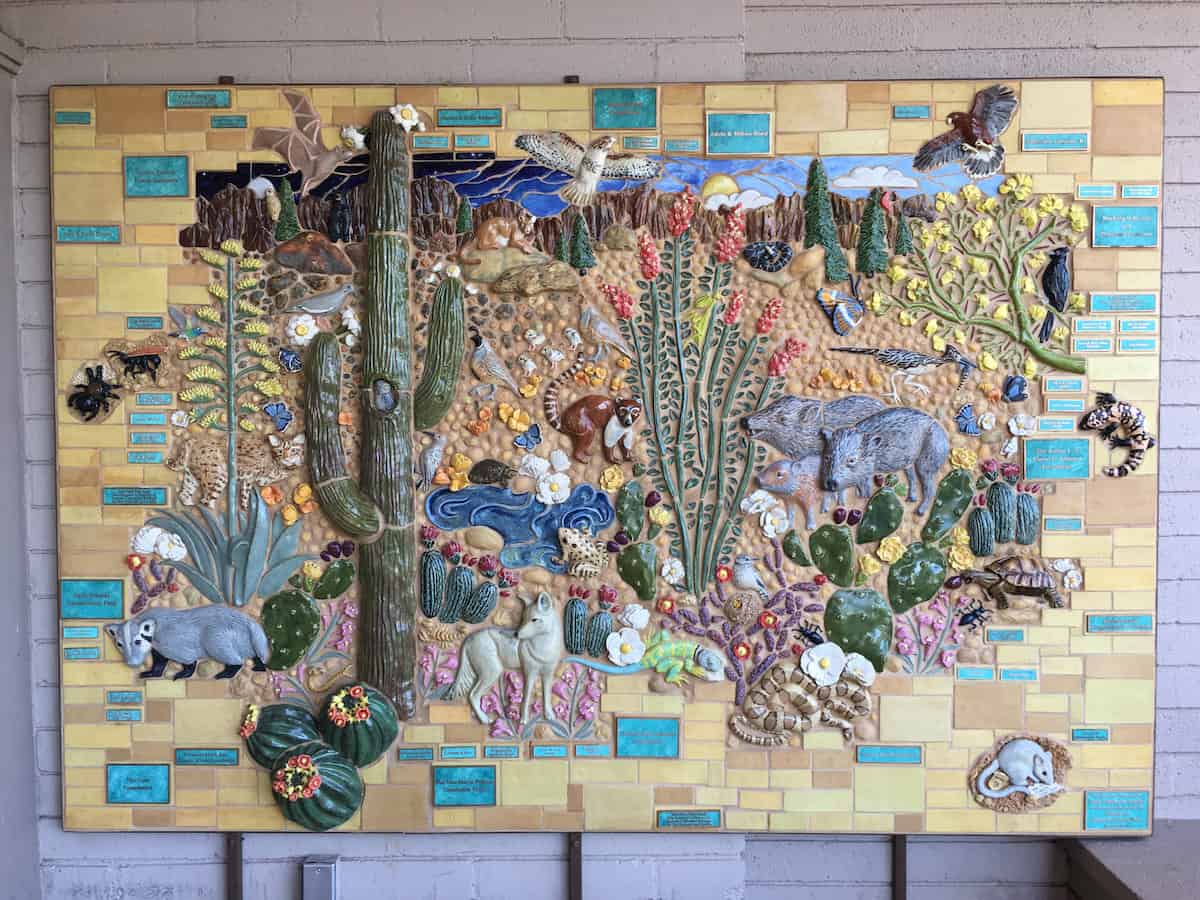
Visitor Centers in Saguaro National Park
Each side of Saguaro National Park offers a visitor center with restrooms and watering stations. Visitors will find maps, Junior Ranger booklets and rangers to ask questions. Each visitor center offers interpretive areas and outside visitors can stroll through its cactus garden with interpretive signs explaining the unique plants of the desert.
Red Hills Visitor Center is located on the west side of the park. On the east side, visit the Rincon Mountains Visitor Center. Each is open from 9 a.m. to 5 p.m.
Scenic Drives in Saguaro National Park
One of the top things to do in Saguaro National Park is to drive through the park, enjoying its unique landscape. During our trip, we even spotted animals, like the Jack Rabbit and road runner.
For a scenic drive on the east side of the park, take the 8-mile Cactus Forest Drive for its Saguaro cactus and views of the Rincon Mountains. It offers parking areas with interpretive signs along with pull-outs.
On the west side of the park, the Bajada Loop Drive is a 5-mile route with ironwood trees. Also find views of the desert landscape along with pull-outs perfect for photos.
Top Things to Do at the Grand Canyon’s South Rim
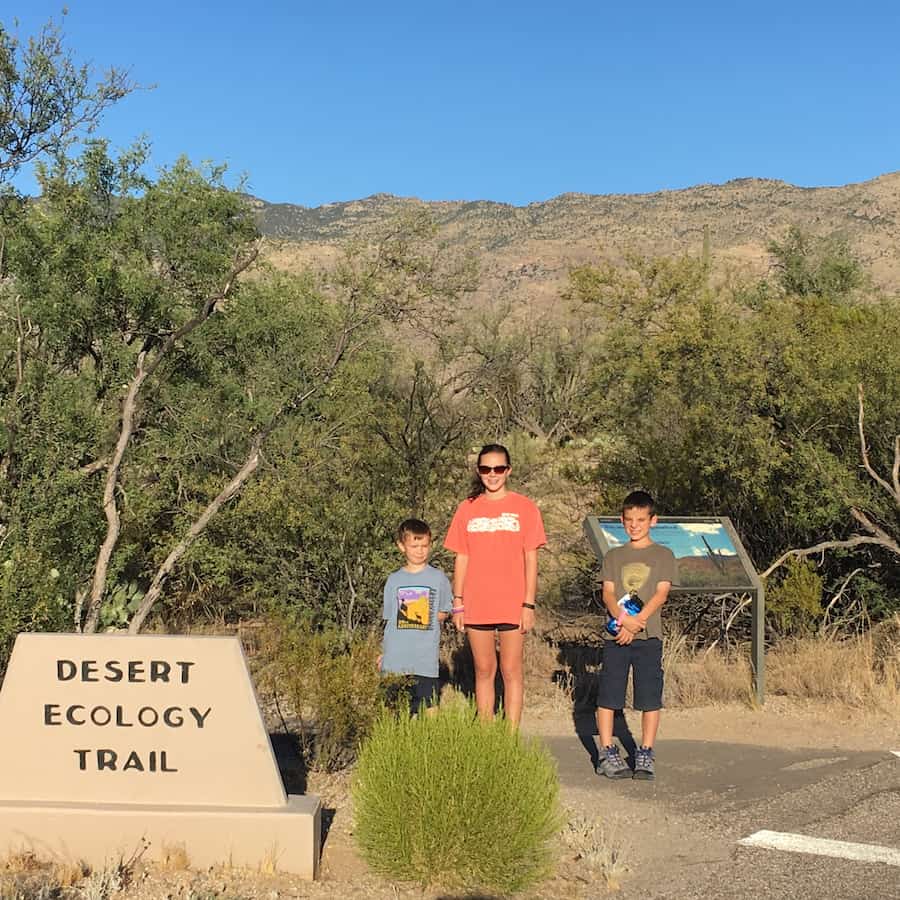
Hiking and Mountain Biking in Saguaro National Park
See more of Saguaro National Park on a hike. Each side of the park offers hiking trails from easy to more advanced. For questions about hiking trails and conditions, check in with a Park Ranger at the Visitor Center. A map is also advised and available at the visitor center. Remember to carry water regardless of the length of the hike. Water is located at both visitor centers.
West Side of the Park
- Desert Discovery Trail—A .4-mile trail west of the Red Hills Visitor Center.
- Wild Dog Trail—A 1.8-mile in-and-out trail off of Hohokam Rd.
- Petroglyphs at Saguaro National Park
East side of the Park
The Cactus Forest Loop Drive offers a few hikes.
- Desert Loop Ecology Trail—A .25-mile accessible nature trail suitable for most. This is the only trail open to pets.
- Freeman Homestead Trail—A .9-mile trail with a 100-foot elevation to an old homestead.
- Mica View Trail—A 1.5-mile in-and-out trail off Cactus Forest Loop Drive, can be joined with Cactus Forest Trail to make a 2-mile loop.
- Loma Verde Loop—A 3.8-mile loop (with 60-foot elevation gain) in the Cactus Forest area that joints the Pink Hill Trail and the Squeeze Pin to form a loop.
The west side (Tucson Mountain District) features over 200 prehistoric petroglyphs that date back to 550 to 1500 years ago. Hikers can see them along the trail in the Signal Hill area.
Located off Golden Gate Rd., it’s a short walk (.1 mile with 40 feet elevation gain). This area features a picnic area and restrooms. Note: roads to Signal Hill are unpaved.
9 Resorts for You in Scottsdale
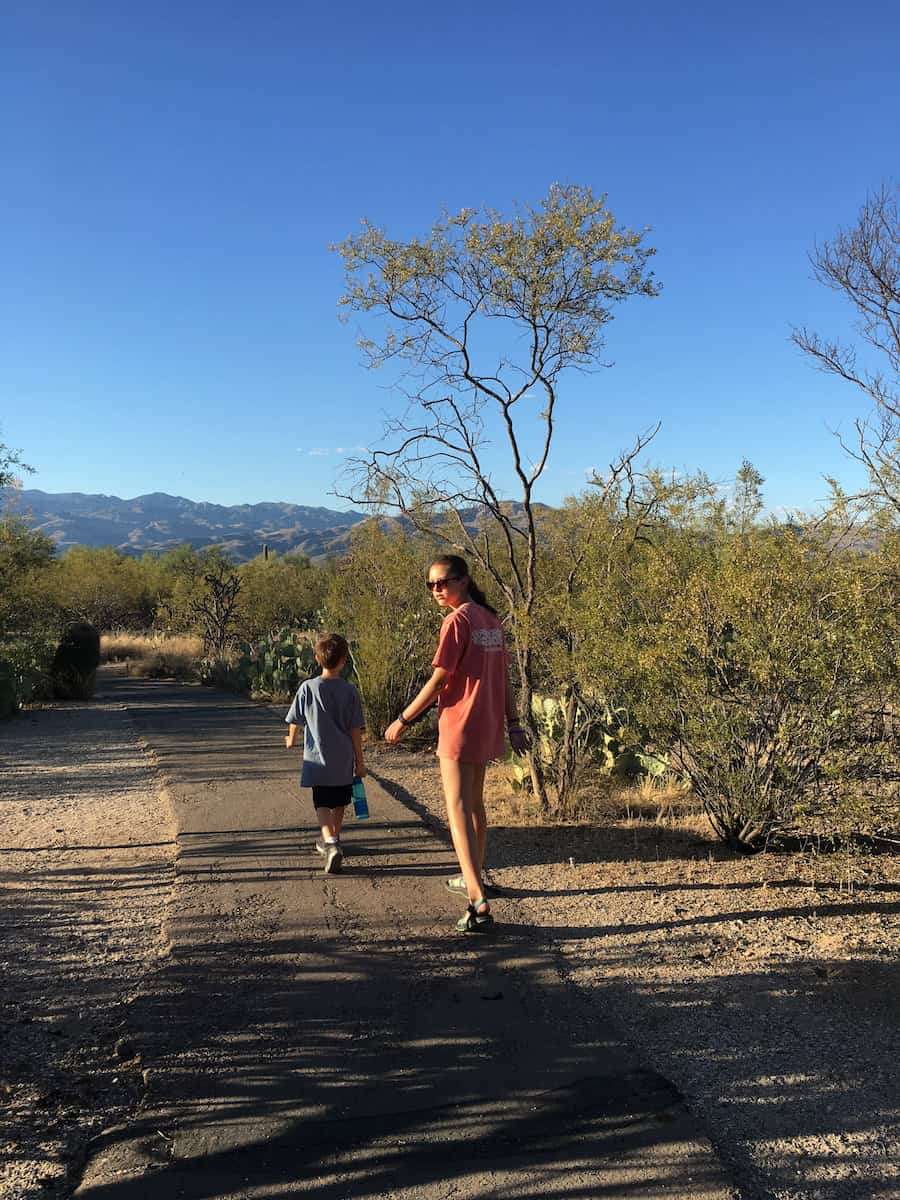
Saguaro National Park with Kids
The Junior Ranger Program is the go-to program for families to learn more about a National Park Service site. It’s free and takes about two hours to complete. My kids love the badges that the Rangers present them after completing their booklet.
Pick up a booklet at the visitor center and complete it during your visit to be sworn in by a park ranger. If you don’t finish, no worries, you can mail the booklet back to Saguaro National Park.
Learn More about Saguaro National Park
If you have time during your visit, attend a Ranger Program. Saguaro National Park offers a calendar with Ranger Programs so you can plan before your visit.
Ranger programs include 30-minute garden walks where visitors can experience the diversity of the desert. Kids might enjoy a talk on the animals of Saguaro National Park, like the lizard or the mountain lion. There are even talks about the night skies over Saguaro.
Guide to Junior Ranger Badges You Can Earn at Home
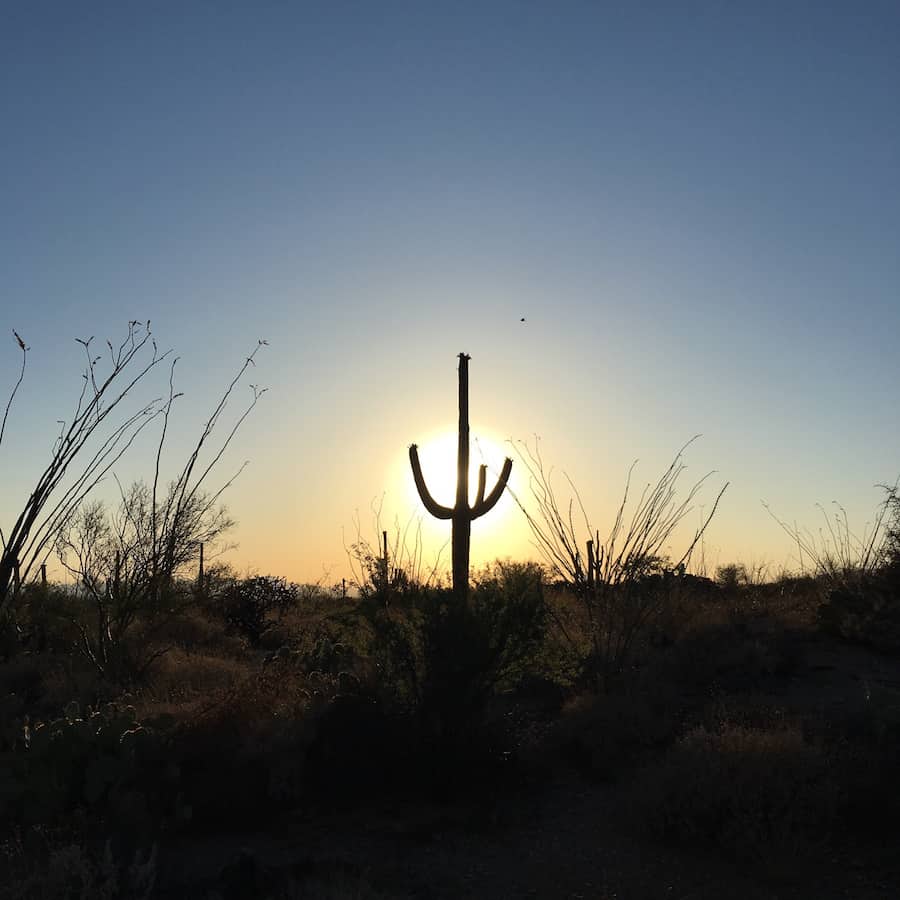
Where to Watch the Sunset at Saguaro National Park
Beach sunsets are inspiring, though desert sunsets are surprisingly impressive for first-timers. Each side of the park offers prime sunset viewing spots, so try to celebrate the sunset during your visit.
In the Rincon Mountains District (the East Side of the Park) head to the Tanque Verde Ridge Trail, a .5-mile hike. It is located off of Cactus Garden Dr. The Javalina Rocks Pull-Out is another top spot without a hike.
On the west side of Saguaro National Park, Gates Pass Scenic Lookout is popular, located in the Tucson Mountain Park, just south of the Saguaro National Park.
Guide to Visiting Death Valley National Park

The Plants of Saguaro National Park
Some find it hard to believe that over 3,000 different species live between the two sides of the park. Adapted to survive long periods of hot and dry weather, the plants will burst with color in a matter of days after a rain shower. The desert will transform from lifeless to lively with blooms and new green leaves.
Saguaro National Park is home to 25 different species of cactus, including the Saguaro. With blooms from hot pink to yellow to white, cactus flowers are showy. Though looks can be deceiving with cacti and always be weary of their thorns, the soft-looking Cholla Cactus is also known as the Teddybear cactus. Its thorn might be small and soft-looking but still hurt, especially those curious enough to touch, like kids and pets.
The Saguaro Cactus
Native to the Sonoran Desert, the Saguaro is the largest species of cactus in the park. It’s the star of the show.
First-time visitors are amazed at how tall a full-grown Saguaro actually is. Extremely slow-growing, the Saguaro Cactus grows about an inch a year in its early years, so the tallest cacti are hundreds of years old.
To see its blooms, visitors should come between April and June. The creamy white blossoms open overnight. A favorite of nectar-feeding bats and other insects, the flower closes the following afternoon. If pollinated, it will form a fruit.
Rain in the desert can be short-lived and intense. The Saguaro’s pleated skin helps it adsorb water quickly and store it for the long, day days ahead. Its skin is a favorite for other creatures, like the Gila woodpecker, one of a few birds that nest in cavities in the Saguaro.
National Park Road Trips Close to LA
Wildflowers in Saguaro
For wildflower blooms, visitors should visit during late February through March. The saguaro blooms in late April, and their fruit ripens in June. From California poppies to desert globemallow to Indian blanket, wildflowers are the best after winter rains.
As a desert environment dedicated to cacti, there’s more to the desert landscape in Saguaro. From Ironwood to the Pinkflower hedgehog cactus, the desert offers a striking landscape.
Animals in Saguaro National Park
To the first-time visitor, the desert might seem devoid of animals, especially during the summer. Even as visitors drive through the Saguaro National Park, animals can pop out of their hiding places.
With warm winter temperatures, Arizona is a birder’s paradise.
- Vermillion Flycatchers
- Whiskered Screech Owls
- Gila Woodpeckers
- Mexican Jay
- Yellow-Eyed Juncos
Gila monsters, Jackrabbits, and kangaroo rats are numerous at the lower elevations. In the higher regions of the park, visitors might spot a black bear and whitetail deer.
The History of Saguaro
Community support and several prominent residents of Arizona worked to preserve the native desert landscape starting in the 1920s. Like many national parks, Saguaro was protected as a national monument first. In 1933, President Herbert Hoover designated the land as Saguaro National Monument.
Over the years, additional land has been added, and the Tucson Mountain District (west side) was integrated into the national monument in 1961. In 1994, the national monument was elevated to a national park by President Bill Clinton.
The People of Saguaro
In addition to the desert landscape, visitors will find cultural resources during their visit. The Hohokam people lived in the area from 500 to 1400 CE, leaving markers on several rocks in the Signal Hill Area. Before the Hohokam people, archeologists in the park have found evidence of Archaic people (3500 to 2100 BCE).
In more modern times, old homesteads and equipment have been discovered, like the Freeman Homestead. The Civilian Conservation Corps (CCC) also developed the area during the Great Depression by constructing several picnic shelters across the park.
Picnic Areas in Saguaro National Park
Find picnic areas on both sides of the park.
East Side
- Javalina Picnic Area
- Mica Picnic Area
West Side
- Mam-A-Gah Picnic Area
- Signal Hill Picnic Area
Where to Stay in Saguaro National Park
Saguaro National Park doesn’t offer lodging inside either side of the park. Both locations are close to Tucson, with numerous options for lodging, dining, and other activities.
Camping in Saguaro National Park
Camping in Saguaro National Park is primitive and requires a multi-mile hike with an elevation change of at least 1,000 feet. A wilderness camping permit must be filled out.
Tucson Mountain Park
On the western side of the park, campers can find developed campsites. The Gilbert Ray Campground offers 130 RV sites (with hook-ups) along with five tent-only sites and rates start at $10 a night for tents and $20 for RV sites. This is a better place to camp than Saguaro National Park. The Tucson Mountain Park also features three picnic areas.
Located at 8451 W. McCain Loop. Free to enter.
Where’s Saguaro National Park
Both sides of the Saguaro National Park area are located in Tucson. To reach the west side of the park, it’s about 15 miles from downtown Tucson to the Red Hills Visitor Center. The Rincon Mountains Visitor Center is about 18 miles east of the city center. To travel from one side of the park to the other will take about an hour, depending on traffic and they are about 30 miles apart. Tucson offers a mid-sized airport along with all traveler’s services.
Saguaro’s West Side is about 115 miles from Phoenix, Arizona. Phoenix is a better option for travelers arriving by air since it offers more flights from more air carriers.
It is open 365 days a year and 24 hours a day. Use an America the Beautiful annual pass ($80) or purchase a 7-day pass for $25 per vehicle.
How to Get into a National Park for Free


